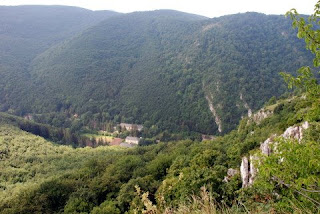



Although we had previously visited Budapest, we wanted to see it again and so, armed with day tickets for Budapest public transport, we set off for the train station. The weather was not good and we were wearing coats and carrying an umbrella – it was positively cool in the wind.
We went all over the city visiting sites that we didn't visit last time as well as revisiting some of our favourite sites. Markets are always fascinating places to visit but the Budapest Central Market is also in a lovely building, so it is particularly good. It seemed that there were as many tourists as there were local shoppers and the upper level of the market, an open metal walkway overlooking the rest of the market, was largely devoted to tourist shops and eating places. The food here looked fantastic, as it did last time that we visited, and if it hadn't been so early (11:30), we would have eaten there. Next time that we come to Budapest, I will definitely arrange to be at the market at lunch time.
We used trains, buses, trams and metros to get into and around the city and this included mainland Europe's first underground railway that runs down the main Andrassy road. This was fascinating as the carriages are very low (not built for rugby or basketball players) and the line is very shallow, the road must be resting on the roof of the railway. We visited the Underground Railway Museum at the Deak Ter station and read about the history of the line. The building of the railway was initiated by Mor Balazs, a Hungarian who had been educated in England and who had obviously seen the London Underground, the world's first such railway. The line was opened in 1896 and despite huge damage in the Second World War, has been running ever since.
To end the day we decided to walk over the chain bridge before catching a train back to the campsite. Last time that we came across here was with our friends Ann and Nick when there on an anniversary of the Hungarian Uprising. The bridge tableaux of students acting out scenes from the Uprising and the road tunnel on the Buda side were full of exhibitions about life at the time. This time there was a Summer festival that and we started by listening to the Ferenc Radics Ensemble playing Hungarian Folk and Romanian Gypsy music. Ferenc Radics is the first violinist in the Hungarian State Folk Orchestra, needless to say, he was very good! In the centre of the bridge was a folk music and dance group. Three musicians played a variety of instruments including bagpipes, lute and drums whilst two dancers enticed passing members of the public into dancing with them. At the Buda end of the bridge there was the Union Brass Quintet. It was a really pleasant atmosphere and was a lovely way to finish our visit to the city.
After a short tram trip along the banks of the Danube, we caught the train back to the campsite and found a large coach parked next to Henrietta. A marquee was attached to the coach and a large group of students were sat around on benches. The area around the coach, in amongst the parked motorhomes, were their tents. They were very loud Americans and were playing a game of 'I never, never .........', the rules and purpose of which I couldn't understand but seemed to involve taking it it turns to say things they hadn't done of a sexual nature. This went on for a long time at high volume and, given that they were only 5 metres away, we were wondering whether we were going to get any sleep that night. Fortunately, at about half past ten most of them decided to go into Budapest and hit the bars and clubs. The remaining students were quite quiet and we were able to get to sleep although we were certain that we would be woken when the others returned.
Photos: The 'Pal Street Boys' – an excellent set of bronze sculptures depicting a scene from a famous Hungarian children's novel; An early Budapest tube train in the Deak Ter museum; A bride and groom posing for photographs in Heroes Square; The folk group on the Chain Bridge.


















































